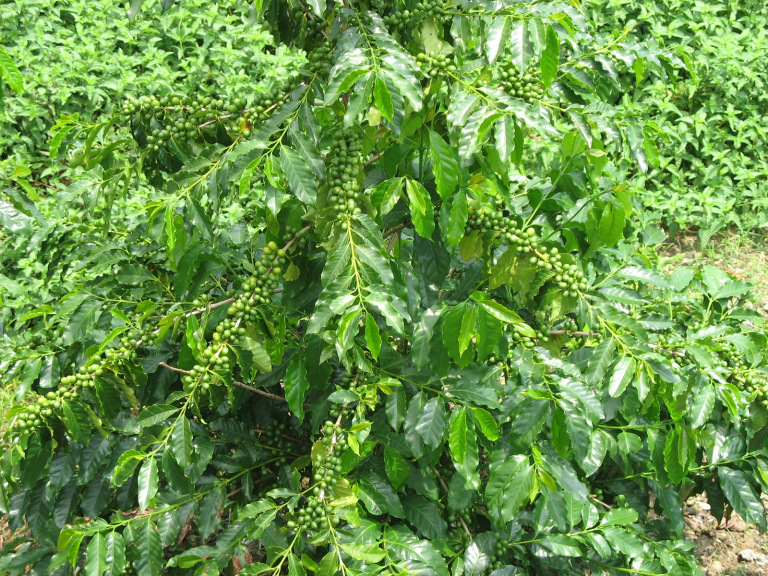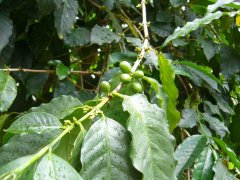What are the conditions for growing coffee? What are the cultivation methods of coffee trees? When to fertilize?

Professional coffee knowledge exchange more coffee bean information please follow the coffee workshop (Wechat official account cafe_style)
What are the fruits and seeds of coffee? What the coffee beans look like.
Coffee trees should not need special care-but sunshine should be sufficient and water should not be scarce.
Basic cultivation Environment and Management of Coffee
I. Coffee climate and local conditions
The cultivation of coffee is mainly limited by temperature, and the suitable temperature is 15 ℃ 24 ℃. If it is more than 30 mm, it is easy to burn the leaves. The average rainfall is 1500 mm. It is better to enjoy dry and low temperature environment in winter, which is beneficial to flower bud differentiation and harvest drying. The root of coffee has a high demand for oxygen, so the soil must have good drainage. Arabica is the most suitable for pozzolanic geological soil. Robusta is suitable for growing in soil rich in humus, and the suitable pH value is between 5.2 and 6.2.
Second, the pruning of coffee
Coffee began to bear fruit after 3-4 years of planting, and after several years of harvest, the fruit gradually grew to the end of the fruiting branch, resulting in a decline in yield and quality. There are two ways, one is for the whole coffee garden, the plants are renewed in turn with different multiples, and the other is to keep each coffee plant with 3 main branches, and each main branch is renewed in turn to maintain good tree potential and fruit quality.
Third, fertilization of coffee
In general, 2:1:1 (N:P:K) fertilizer can be used for coffee in the first year, and 3:2:2 (N:P:K) fertilizer can be used in the second year, and then the proportion of phosphorus and potassium fertilizer increases year by year. Fertilizer should also make some adjustments to the climate and environment, such as high temperature and high light can increase the proportion of potash fertilizer, such as low temperature and low light environment can increase the proportion of nitrogen fertilizer, reduce the application of potash fertilizer. In addition, the detection of soil fertility and physical properties can be used to carry out correct fertilizer management and improve yield and quality.
Common sense of Coffee Tree planting
Coffee trees grow in the tropics between Tropic of Cancer and Tropic of Cancer and near the equator. There are also great differences in appearance among the so-called world coffee growth zones, caffeine varieties and regional factors. With long green leaves ranging from yellowish green to dark green or even to brass, these shiny trees are wavy, which is more pronounced in Robasda than in Arabica.
Although coffee trees need irrigation, pruning, weeding, fertilization and root protection, if the soil is not the best condition for coffee trees, it will not bear fruit for several years. The coffee tree grows most luxuriantly in the soil full of nitrogen, potassium carbonate and phosphoric acid. When the tree is 4-5 years old, the first fruit will soon reach the yield peak, and will continue to bear fruit if it is well cared for in 20-25 years.
One of the characteristics of a coffee tree is that its fruit can bear fruit several times a year, and another is that flowers and fruits (also known as cherries) coexist at different stages of ripening. The style of the whole coffee industry is influenced by the fickle nature. If the fruit is too ripe, the beans in it will rot. If it is not ripe enough, the beans picked will not ripen by themselves. So bean pickers often go back to the same tree several times to look for ripe fruit-trying to get only 2 pounds of green coffee beans, usually an average of 2 pounds a year. Keep this in mind the next time you buy coffee.
Coffee farmers who produce low-grade coffee beans like to use labor-saving methods to harvest beans, but in this way, because the quality is not pure, it impairs the flavor of coffee and lowers the grade of coffee. The way to pick coffee beans in some parts of Africa is to shake coffee trees, shake the fruit off the ground, and pick it up from the ground before the fruit is injured and rotten. Secondary coffee is produced in most parts of Brazil, where coffee is picked by plucking all the leaves, flowers, overheated and green fruits from the branches at a time, and it takes two years for such damaged coffee trees to return to normal.
The delicate white flowers of coffee trees are a rare spectacle, which smells like oranges and jasmine. Sometimes it is just a tree blooming alone; for example, a young bride, sometimes the whole coffee garden is in full bloom, looking like a sea of white flowers, beautiful and intoxicating, but the flowering period is fleeting. Within two or three days, the petals dispersed with the wind, leaving only the remaining fragrance to spin around in the air.
Before long, small fruits appeared in piles, first green, then yellow, then red and crimson, and when they almost turned black, they could be harvested in Jamaica. Bats were the first to know whether the fruit was ripe or not. They sucked coffee pulp at night, telling farmers that the fruit was ripe and ready to be harvested. The oval fruits gather tightly around the branches, and the slender, smooth dark green toothed leaves are opposite on both sides of the branches. The leaves on the sunny side are harder and the back is softer and paler, and the edges are fan-shaped. The branches are also opposite from the trunk.
Evergreen trees are usually bred in nurseries, grow into seedlings, and then move to coffee farms a year later, in full compliance with the way the early Arabs planted and cultivated coffee trees. In the first four or five years of its growth, the coffee tree will continue to take root downward, develop its trunk upward, and develop its branches into an umbrella shape so that it can bear rich fruit in the future.
There are three main commercial varieties of coffee trees, and there are different classifications under these three varieties. Arabica coffee (arabica) coffee is the most important and the best quality coffee beans, derived from Isopia, is currently the most widely cultivated coffee. Lieberita Coffee (liberica) originates from Liberia Nobasta (robusta) originates from Congo. The name of the latter shows that it is stout, able to resist bad weather and disease; it does not need much manual care when preparing land, weeding and pruning, and can be allowed to grow in the wild of woodland. Although it tastes more bitter than Arabica, its quality is much lower than that of Arabica. Most Africans drink Nobasta coffee. Because of its high output, it is used to make instant coffee. Arabica coffee is suitable for growing at an altitude of 2000,000ft above sea level-the higher the altitude, the better the quality, while Liburita and Nobasta are best grown below 2000 feet above sea level.
Coffee trees can only grow in the tropics and subtropics. Coffee trees can grow in different climates, soils, elevations and rainfall in the middle of the "coffee belt". In Africa's hot and humid canyons and forest rainforests, coffee trees thrive; in cold, foggy, windy Central America it still produces high-quality coffee beans; and in the Caribbean, where the climate is changeable, drought and torrential rain, it still blossoms and bears fruit. These factors are the secret that coffee beans have different flavors and a wide variety.
The ideal growth environment is a temperature between 65 and 75 degrees Fahrenheit, an appropriate altitude and annual rainfall (between 40 and 120 inches). The timing of rainfall is very important, it is best to have intervals of heavy rain and strong sunshine during maturity, and a period of dry weather is needed for harvest. Any form of soil is suitable, but the best soil is a mixture of decomposed volcanic soil, humic soil and permeable soil.
The sunshine time during the day is not very long, a few hours is enough. The hillside is an ideal location because of its short viewing time and good drainage. Coffee trees like wet roots, tall trees with most leaves planted in the coffee garden, on the one hand to protect against the wind, on the other hand shade.
As for the disasters of coffee trees, frost damage and leaf diseases are the most common killers.
.
Important Notice :
前街咖啡 FrontStreet Coffee has moved to new addredd:
FrontStreet Coffee Address: 315,Donghua East Road,GuangZhou
Tel:020 38364473
- Prev

Coffee planting technology: how to make coffee trees grow up quickly? Improve the success rate of planting?
Professional coffee knowledge exchange more information about coffee beans Please follow the coffee workshop (Wechat official account cafe_style) what are the fruits and seeds of coffee? The coffee tree is a tropical plant that belongs to an evergreen shrub that grows at the equator and 25 degrees north and south latitudes, that is, within the Tropic of Cancer. Near the Tropic of Cancer and the equator is the world coffee.
- Next

How to describe the aroma of coffee professional terms 36 common aroma names of coffee
Professional coffee knowledge exchange more coffee bean information Please pay attention to the meaning of wet and dry aroma of coffee in coffee workshop (Wechat official account cafe_style) the seven factors that affect the flavor and aroma of coffee the aroma of coffee is mellow, the aroma of coffee is overflowing, the coffee is slightly bitter, released from the mouth, that special smell. These are the only adjectives for all kinds of tastes.
Related
- Beginners will see the "Coffee pull flower" guide!
- What is the difference between ice blog purified milk and ordinary milk coffee?
- Why is the Philippines the largest producer of crops in Liberia?
- For coffee extraction, should the fine powder be retained?
- How does extracted espresso fill pressed powder? How much strength does it take to press the powder?
- How to make jasmine cold extract coffee? Is the jasmine + latte good?
- Will this little toy really make the coffee taste better? How does Lily Drip affect coffee extraction?
- Will the action of slapping the filter cup also affect coffee extraction?
- What's the difference between powder-to-water ratio and powder-to-liquid ratio?
- What is the Ethiopian local species? What does it have to do with Heirloom native species?

